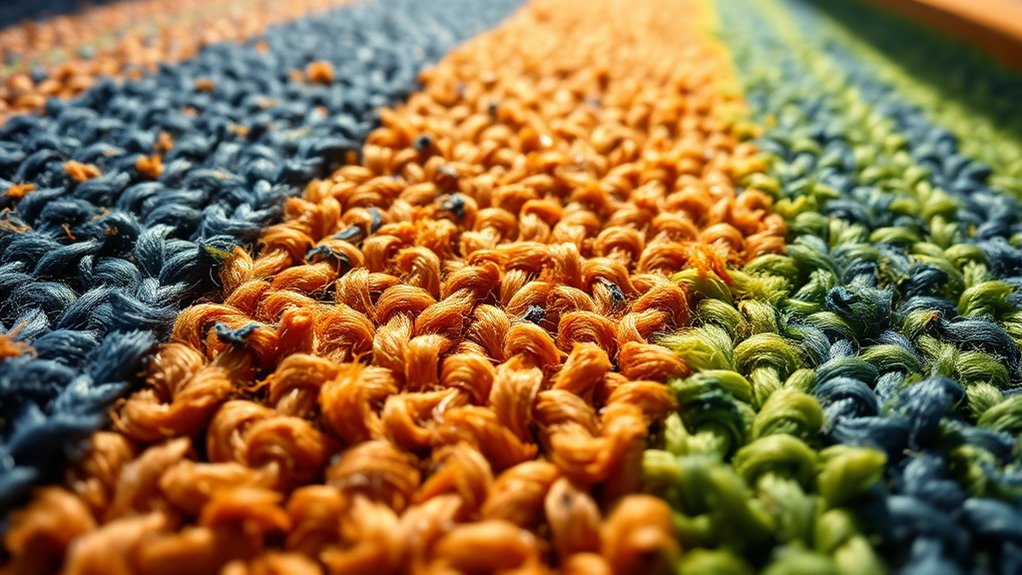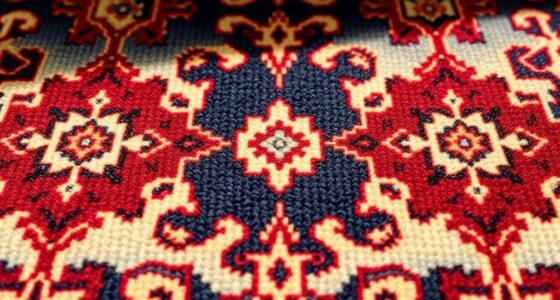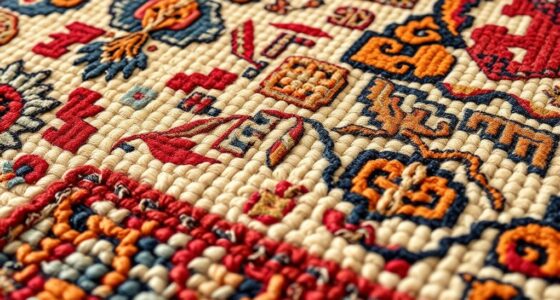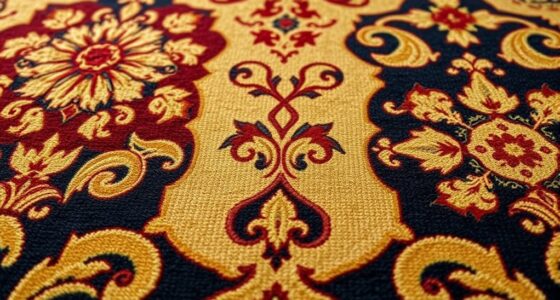Many believe vegetable-dyed carpets fade instantly under sunlight, but that’s a myth. While UV exposure can cause fading over time, proper treatments, mordants, and protective measures can considerably extend their color longevity. Factors like fabric type, dye composition, and sunlight intensity all influence fading, which is a gradual process. By understanding these elements and applying simple preservation tips, you can keep your carpet vibrant longer—learn more to uncover effective ways to protect your investment.
Key Takeaways
- UV fading of vegetable-dyed carpets is a gradual process, not an immediate or unavoidable outcome.
- Proper preservation techniques, like protective coatings and limited sunlight exposure, significantly extend carpet vibrancy.
- Myths suggesting vegetable dyes are highly susceptible to UV damage overlook advances in dye stabilization and mordant use.
- Regular maintenance and strategic placement can prevent or delay fading caused by sunlight.
- Educating on UV effects dispels misconceptions, enabling better preservation and longer-lasting color in vegetable-dyed carpets.
Understanding Vegetable Dyes and Their Composition
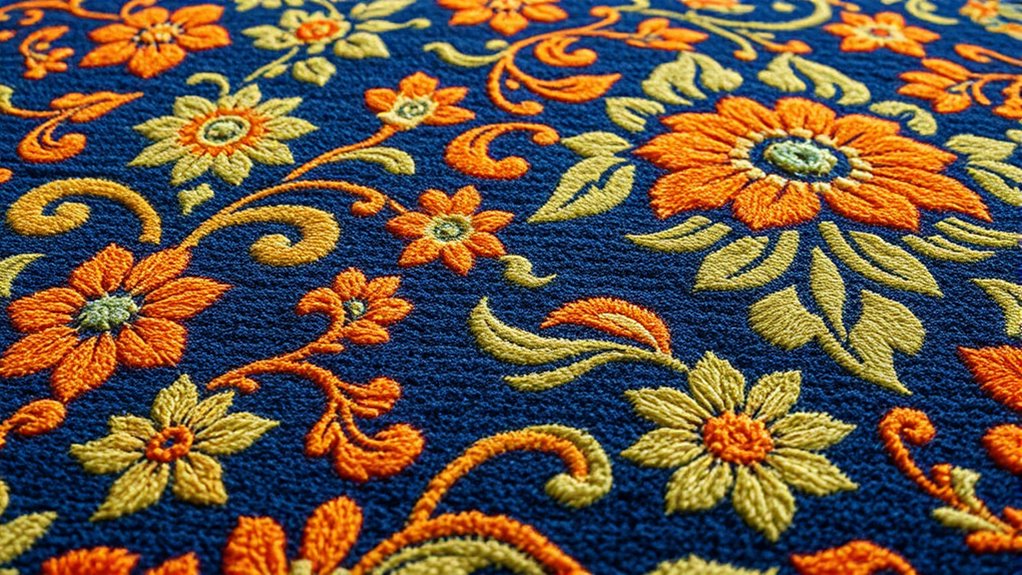
Vegetable dyes are natural colorants derived from plant sources, and understanding their composition helps explain their vibrant hues and limitations. These dyes contain natural pigments that bind to fibers, creating rich, earthy tones. The effectiveness of a vegetable dye often depends on mordant effects, which involve using metal salts to enhance color intensity and fixation. Mordants can alter the shade, making the dye more vibrant or altering its hue, but they also influence how well the color resists fading over time. Unlike synthetic dyes, vegetable dyes are sensitive to environmental factors, making knowledge of their composition essential for proper application and preservation. Recognizing the role of natural pigments and mordant effects helps you appreciate the unique qualities and vulnerabilities of vegetable-dyed textiles. Additionally, different electric bike conversion kits can impact the durability and performance of dyed textiles if used in outdoor or high-traffic environments. Furthermore, understanding security measures related to textile preservation can help protect these delicate dyes from environmental damage, especially considering their sensitivity to sunlight, which can accelerate fading. Proper storage and display techniques, such as UV-protective coverings, can further extend the lifespan of vegetable-dyed textiles. Being aware of environmental control methods is also crucial to maintaining their color integrity over time.
Factors Influencing UV Stability in Dyes
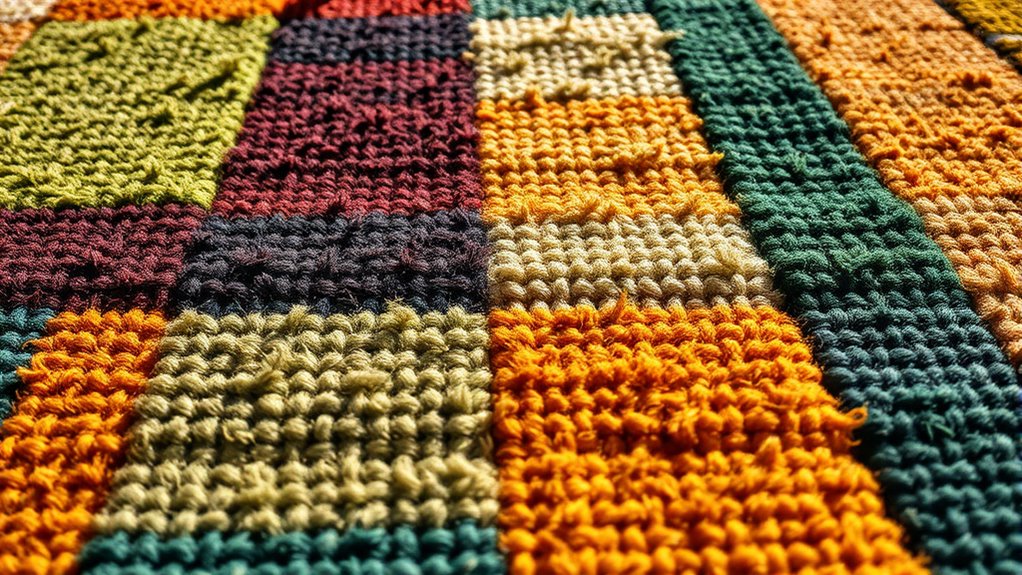
The composition of dyes, including the natural pigments and mordants you’ve learned about, plays a significant role in how they respond to UV exposure. Factors like chemical reactions within the dye molecules influence dye stability and fading resistance. Dyes with complex structures tend to resist degradation better because they undergo fewer destructive chemical reactions under sunlight. Additionally, the presence of mordants can enhance UV stability by forming protective bonds with pigments. External factors such as sunlight intensity, exposure duration, and environmental conditions also impact dye longevity. Understanding dye chemistry is essential for predicting how dyes will perform under UV light. Moreover, UV resistance can be improved through specific dye formulations designed for enhanced stability. Recognizing the chemical structure of dyes helps in selecting more durable options for sunlit environments. It is also important to consider the lightfastness of different dyes when choosing colors for outdoor or sun-exposed textiles. To illustrate, consider this table:
| Factor | Effect on Stability | Explanation |
|---|---|---|
| Chemical Reactions | Destabilize dyes | UV light triggers reactions degrading pigment molecules |
| Mordants | Improve stability | Form bonds protecting dyes from UV damage |
| Sunlight Exposure | Accelerates fading | Longer exposure increases degradation risk |
Recent Research on Sunlight and Vegetable-Dyed Textiles
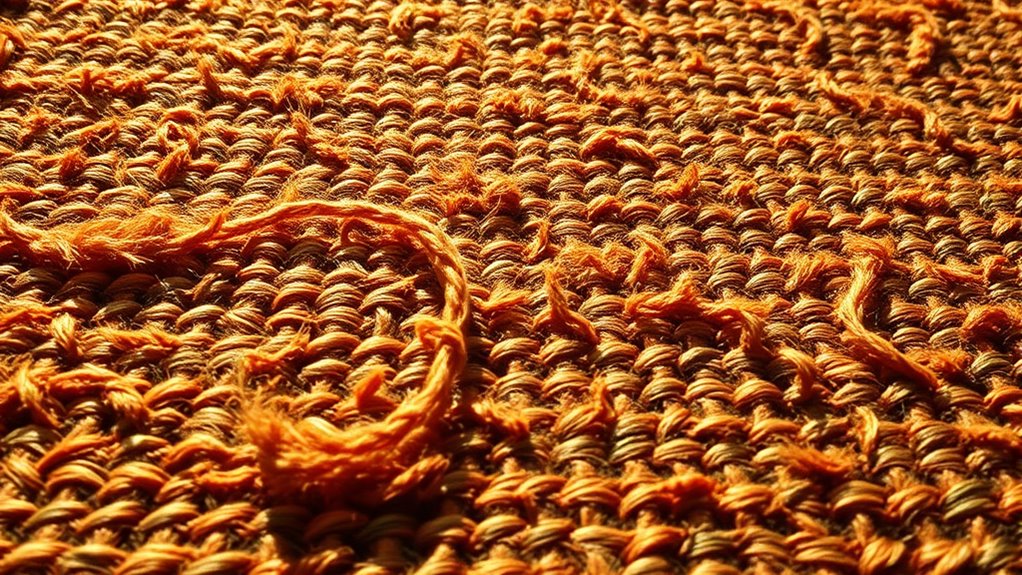
Recent studies have shed new light on how sunlight affects vegetable-dyed textiles, revealing both vulnerabilities and ways to improve their durability. Researchers found that natural colorfastness varies depending on the dye and fabric type, but many vegetable dyes retain their hues better than previously believed. Advances in understanding chemical stability show that certain mordants and mordanting methods can enhance dye resistance to UV exposure. These improvements help maintain the vibrancy of vegetable dyes over time, even under direct sunlight. The research also emphasizes that sunlight can cause subtle changes in dye molecules, but with proper treatment, textiles can resist fading longer. Understanding the impact of sunlight on dyes is essential for preserving the charm and durability of natural textiles over time. Additionally, ongoing research into protective coatings and fabric treatments offers promising solutions for extending the lifespan of vegetable-dyed carpets under sunlight. By applying the right techniques, you can enjoy sunlight on your vegetable-dyed carpets without compromising their beauty or longevity. Proper treatment methods are key to ensuring their vibrant appearance endures over time. Furthermore, the development of UV-resistant coatings provides an extra layer of protection, helping textiles withstand prolonged sun exposure and highlighting the importance of innovative textile chemistry in textile preservation. Incorporating UV stability testing into production processes can further ensure long-term color retention in dyed textiles.
Tips for Protecting Your Carpet While Enjoying Sunlit Spaces
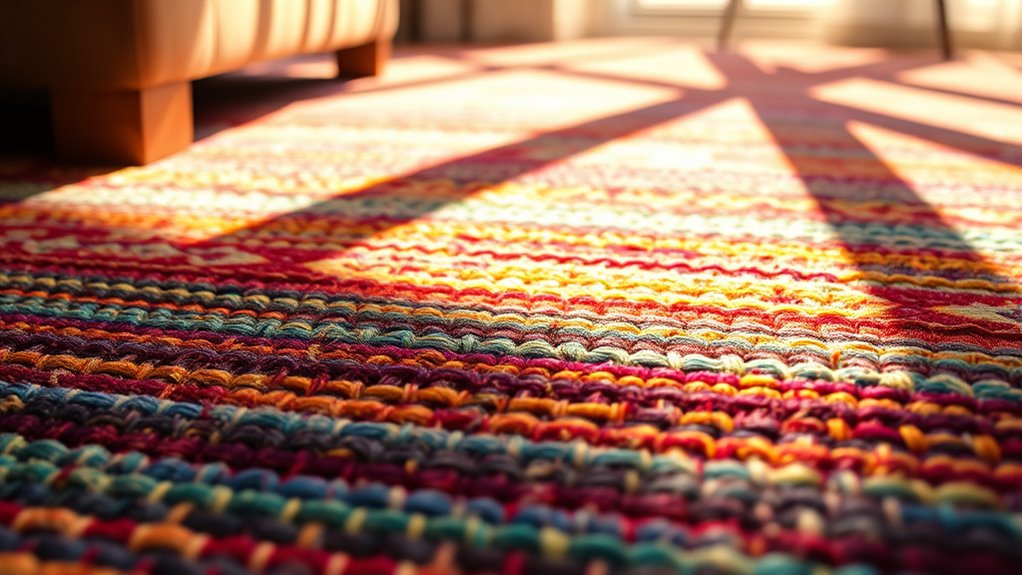
To protect your carpet from sunlight while enjoying its warmth and natural light, it’s essential to take proactive steps that preserve its vibrant appearance. Limiting direct sunlight exposure helps prevent fading of natural pigments in vegetable-dyed carpets. Use sheer curtains or UV-filtering window films to diffuse sunlight and reduce its intensity. Rotate your rugs regularly to ensure even exposure and prevent uneven fading. Place furniture or decorative screens strategically to shield high-traffic areas during peak sunlight hours. Additionally, consider relocating your carpet away from direct sunlight if possible. Being aware of signs of spoilage in materials can help you identify wear or damage early. Incorporating proper maintenance practices, such as gentle cleaning and avoiding harsh chemicals, can also extend the life of your carpet by keeping it clean and free of debris. Regularly inspecting your rug for UV damage can help you address issues before they become severe. These simple measures help maintain the richness of natural pigments and prolong the lifespan of your carpet, so you can enjoy sunlit spaces without compromising its beauty.
Debunking Common Misconceptions About UV Fading
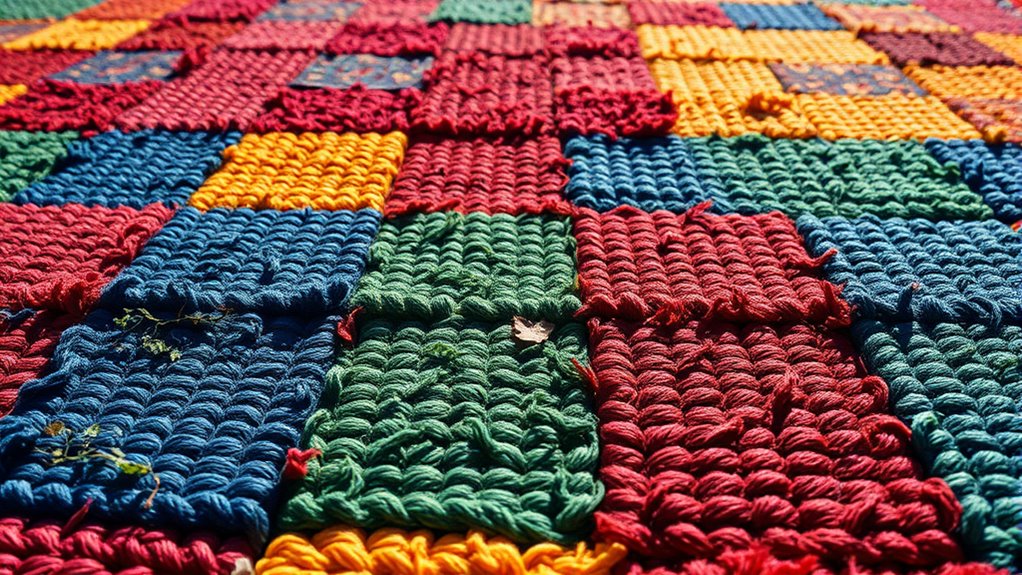
Many people believe UV fading happens instantly or only after long exposure, but this isn’t true. UV fading results from chemical reactions triggered by sunlight, which gradually break down dye molecules in your carpet. The process is slow and depends on factors like dye type, sunlight intensity, and exposure duration. Some think vegetable dyes fade immediately when exposed to sunlight, but their dye longevity can actually be quite good with proper care. The misconception that fading is unavoidable leads to unnecessary worry. In reality, UV fading is a gradual process, giving you time to take protective measures. Understanding that chemical reactions cause fading helps you appreciate that preservation techniques can extend your carpet’s vibrant appearance, rather than resigning yourself to inevitable fading.
Frequently Asked Questions
How Long Do Vegetable-Dyed Carpets Typically Retain Their Color Outdoors?
You wonder how long vegetable-dyed carpets keep their color outdoors. Sunlight exposure can affect dye stability, but with proper care, these carpets often retain their vibrancy for several years. Typically, their color fades gradually over 3 to 5 years if exposed to direct sunlight constantly. To prolong their lifespan, consider limiting outdoor sun exposure or using protective coverings, ensuring your carpet stays colorful and beautiful longer.
Are There Specific Vegetable Dyes More Resistant to UV Damage?
When considering vegetable dyes, you wonder if some are more resistant to UV damage than others. You should look for natural dye stability and UV resistant pigments, as these are formulated to withstand sunlight better. Some vegetable dyes, like indigo and madder root, tend to be more durable under UV exposure. Choosing carpets dyed with these pigments can help your colors stay vibrant longer, even when exposed to outdoor sunlight.
Can Certain Cleaning Methods Help Prevent UV Fading?
You can help prevent UV fading by choosing cleaning methods that offer UV protection, especially if your carpets face sunlight exposure regularly. Use gentle, pH-balanced cleaning solutions and avoid harsh chemicals that can weaken dyes. Regular vacuuming and prompt stain removal also preserve the carpet’s color. Additionally, consider applying a UV protectant spray designed for textiles, which creates a barrier against sunlight exposure and reduces fading over time.
Do Uv-Protective Treatments Affect the Appearance of Vegetable-Dyed Carpets?
Did you know that UV protection coatings can enhance a vegetable-dyed carpet’s colorfastness by up to 50%? These treatments often affect appearance minimally, with many offering improved UV protection without altering the vibrant hues. When applying UV‑protective treatments, look for products that promote colorfastness improvements, ensuring your carpet retains its beauty. Proper UV protection helps preserve the natural charm of vegetable dyes while maintaining the carpet’s original appearance.
Is There a Difference in UV Fading Between Natural and Synthetic Vegetable Dyes?
You might wonder if natural dye longevity differs from synthetic dye stability when exposed to UV light. Generally, natural dyes tend to fade faster under sunlight, showing less UV resistance compared to synthetic dyes. This means the colors in vegetable-dyed carpets may diminish more quickly, especially without protective treatments. To preserve their vibrant appearance, consider applying UV-protective coatings, but remember that natural dyes still require extra care to maintain their beauty over time.
Conclusion
Now that you know sunlight isn’t the enemy of vegetable-dyed carpets, you can enjoy your sunlit spaces with confidence. Did you know that recent studies show vegetable dyes can retain up to 80% of their original color after prolonged sun exposure? That’s a proof to their resilience when properly cared for. So, go ahead, brighten your home and bask in natural light — your beautiful, eco-friendly carpets can shine without fear of fading.
